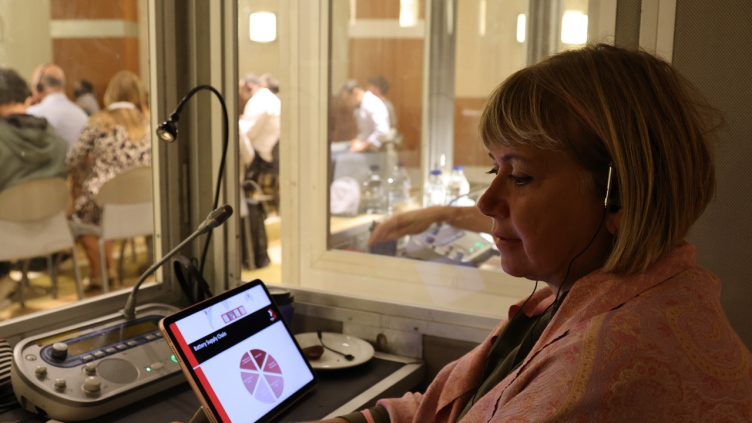
We need interpreters to make multilingual meetings work; likewise, interpreters need the right simultaneous interpretation equipment to provide the best service possible. Naturally, the meeting equipment and setup will depend on the type of meeting. Here is a list of things to keep in mind when choosing the right equipment for your multilingual meeting.
Target Audience
Finding the right setup starts with identifying the target audience. How many participants are expected? An event for 25 people requires a completely different simultaneous interpretation setup than a larger event with 2500 participants. Do you know how your participants will participate to the meeting? If all of your participants will be there in person, you will need on-site equipment. If some of your participants will attend the meeting online, then that calls for a hybrid setup.
Venue
The type of venue is as important as the number of participants. How large is the venue? How high are the ceilings? Knowing the physical properties of the venue is paramount to getting the right audio setup, using screens where necessary, and positioning the interpreting booths correctly. Again, if you will have online participants, you will also need cameras so that they can have audio and video feed from the venue for a smooth hybrid meeting.
Simultaneous interpretation system
The simultaneous interpretation system covers all kinds of equipment for simultaneous interpreting services including booths, consoles, microphones and audio system.
High-quality simultaneous interpretation systems are indispensable for a smooth interpretation experience for both the interpreters and the participants. It is very important to use state-of-the art interpretation equipment compliant to industry standards. It is good practice to work with specialized technical equipment providers instead of event management companies or to consult an interpreter to find the right equipment.
It is also important to make sure that the simultaneous interpretation system is compatible with the audio-visual equipment to be used during the event. The system should be compatible with the desktop delegate microphones, lapel microphones, sound recorders, etc.
Receivers
The receivers integrated to the simultaneous interpretation system come with jacks to connect to the headsets. The receivers allow the participants to select a language and to listen to interpretation on their headsets. The receivers do not come with built-in microphones.
Transmitters
The transmitters send the voices of the interpreters from the interpreting consoles to the participants’ receivers. They also synchronize the language channels.
Booths
There are two types of interpreting booths: fixed and portable. Fixed booths are built-in booths at venues like conference halls or auditoriums. Portable booths are soundproof mobile booths that are usually set-up at the venue a day in advance. It is important to position to booths so that the interpreters can see the speakers. If this is not possible, screens can be placed in front of the booths so that the interpreters can see the speakers as they interpret them. Portable interpretation booths are usually set up for a team of two interpreters with one console for each interpreter. The consoles allow the interpreters to adjust the incoming and outgoing audio volume, turn their microphones on/off, and switch between different language channels to listen and to interpret.
Central Control Unit
The Central Control Unit (CCU) is a device that controls the wired delegate microphones, simultaneous interpretation channels and the audio systems used in meetings. It is used in all meetings with simultaneous interpretation regardless of the type of setup (on-site or hybrid).
Radiators
The radiators send infrared signals for the communication between the receivers and the transmitters. They are placed on poles close to the interpreting booths and the participants.
Microphones
The type of microphones used will depend on the type of meeting. A microphone placed on the rostrum or handheld/lapel microphones for each speaker can be used for meetings with a small number of speakers. Wireless handheld microphones are often used in meetings where audience members are expected to take the floor. Delegate microphones are usually used in roundtable meetings, board meetings or panels where participants take turns to speak. Regardless of the meeting setup, the key is to make sure that all microphones are compatible with the simultaneous interpretation system. It is worth noting that the microphones used in simultaneous interpretation systems must come with a turn on/off option. Microphones left active throughout the meeting will make it difficult for the interpreters to follow two inputs at the same time. Therefore, remember to keep only one microphone active at any point in a meeting.